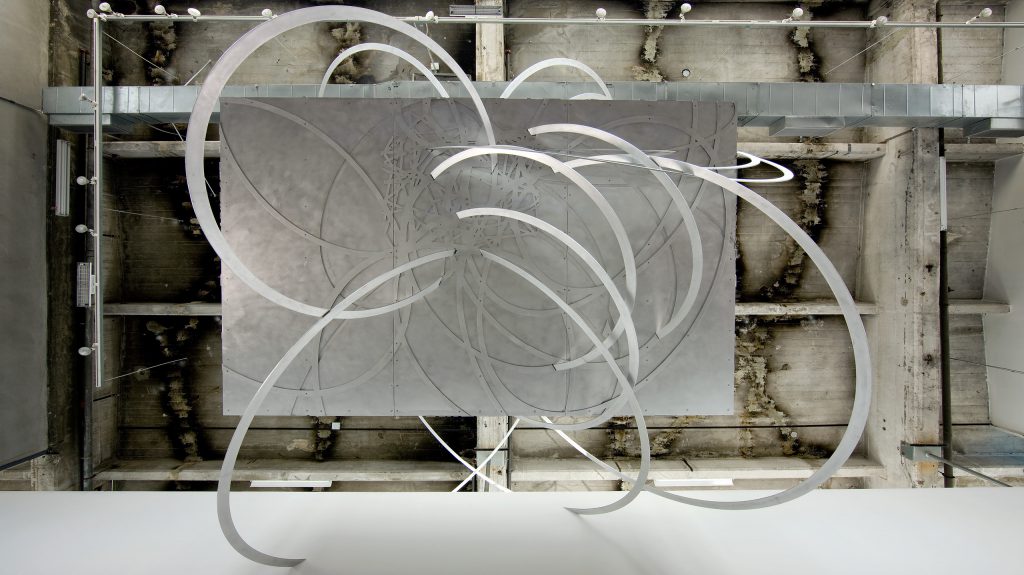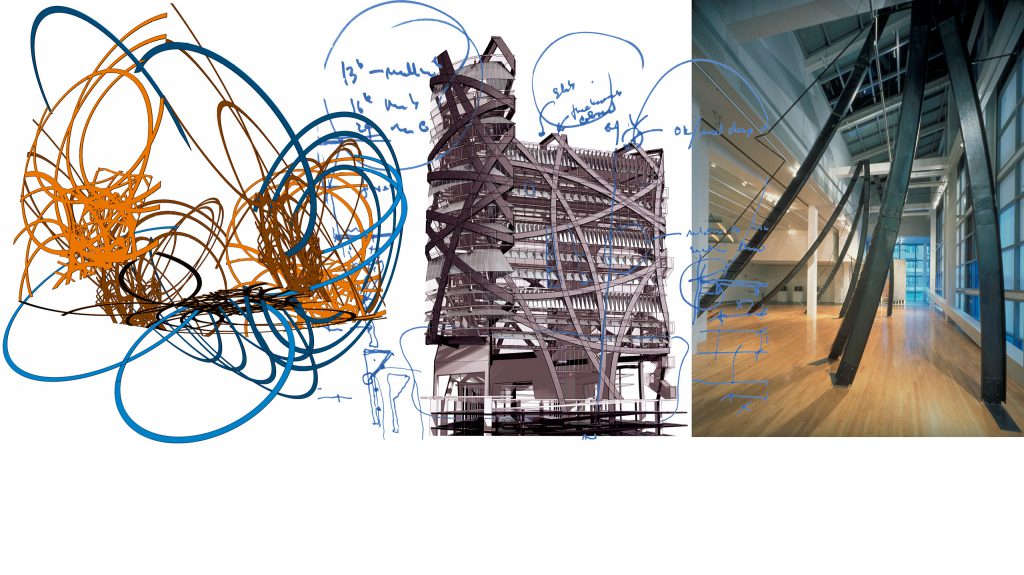Location
Los Angeles and Vienna, Austria
Program
Installation
Dates
2009
Construction Systems
Aluminum
Key Staff
Eric McNevin, Jose Herrasti, Fernanda Oppermann Bento, Kyoung Kim
Key Consultants
Fabrication: Tom Farrage & Co.
Engineering: Buro Happold
Installation: Hinerfeld-Ward, Inc.
Photographer
Tom Bonner
In 1998 the Wexner Center for the Arts in Ohio joined with SFMOMA and NYMOMA in a three museum exhibition and debate examining the intersection of new conceptual design ideas with the burgeoning new capacity to construct objects which, so often in the past, could only be imagined.
The divide that separated visionary architecture from the technical capacity to realize those visions, from Gaudi and Mendelsohn to Lebbeus Woods, seemed, suddenly to be narrowing. Now, the hypothesis went, if you could see it in your head, you could deliver it on the site. And the premise of that exhibit and the surrounding discourse has clearly been confirmed in the recent construction of building ideas that once came to life only in drawing.
The Wexner Center in Columbus was designed by New York architect Peter Eisenman as an admixture of an historic, largely masonry structure, and an exhaustive examination of the organization prospects of the steel grid, as the new building addition. The orthogonal system – the grid as conceptual premise in architecture and city planning — runs backwards for millennia, with landmark stops from Hippodamus at Miletus, the first gridded city plan, to the Park Avenue Lever House and Seagram buildings.
The Wexner addition is the architect’s effort to finally exhaust the promise of the grid as an ordering and space making mechanism. The galleries present the grid as floor, as wall, as roof, as glazing system, and as lighting, and structure. But there was more: the tilted grid, the bent grid, the folded grid. Grids uber alles.
The Moss office in its installation offered the Wexner an entirely different perceptual and space making option. The grid qua grid is centerless, a conceptual neutrality that theoretically extends in every direction, endless, and without a focus.
The Moss alternative examined a contrary ordering mechanism, the curve. The curve suggests a different spatial prospect — the possibility of center. So in the lexicon of shapes, no matter how sophisticated the discussion of intricate geometries, the essential juxtaposition is centered and centerlessness.
Moss built the missing center in the Wexner, supplying the geometric opportunity [intentionally] omitted from the original architect’s design. We called that foreign vantage point the Dancing Bleachers.
The attenuated steel legs – the ribbons — tenuously attached to floor and roof, suggested a concentric order of seats arranged around an implied center. The Moss exhibit at the Wexner implied a spatial center, and simultaneously, a center for advocates to debate, surrounded by a seated group of participants. Hyde Park at the Wexner.
The Wexner exhibit constructed that prospect of a center for debate, surrounded by the studied manifestations of gridded neutrality.
Not long after the three-museum exhibition, the Moss office was invited to design a high rise structure in Los Angeles at the corner of la Cienega Boulevard and Jefferson Avenue, adjacent to a long anticipated surface rail stop intended to connect the Westside of Los Angeles with downtown. The site is located in the south-central portion of Los Angeles in a poor, minority area, well known for two race riots, but for little else — left dormant for years as various other parts of the city were re-developed.
The high rise project was designed, applying the antithetical grid premise first used in the Dancing Bleachers. The tower buildings – there were initially two – were designed without the conventional orthogonal order of columns and beams, but were rather supported with a dense, curvilinear order of ribbons, neither beams nor columns, that densely circumscribed and supported the building.
The Moss office received final planning and design approval from the City of Los Angeles in 2008 to construct the high rise, now a single tower, that will adjoin the downtown to the Westside surface rail route currently under construction.
The tower is called Bondage.
Today the single tower building is being re-drawn and re-engineered by Greg Otto at Buro Happold, interrogating the original conceptual strategy and form making capacity first examined in the Dancing Bleachers.
Construction will begin in 2010.
The Moss exhibit at Sci-Arc scheduled for April, 2009, re-examines both the content of the Wexner exhibition and the premises of the Bondage Tower at la Cienega and Jefferson. Again, the ubiquitous grid of the surrounding concrete gallery space, and, by implication, the enduring grid pro forma that continues to inhabit the planning and architecture discourse is contested by the curvilinear spatial nemesis
It’s past time to defoliate that grid. But if I do that, the opposition between orthogonal and curvilinear is gone.
Architecture needs an enemy.
So we present the ubiquitous grid as a metal box, hung as a conceptual foil from the gallery roof. The ribbons and box intertwine. And Bondage re-makes the grid.
The Moss exhibit promises a colloquium, an audience assembled to observe the grid-in-bondage discourse [which may or may not actually transpire]. And the form language of the ribbons suggests the prospect of a center or of multiple centers, whether or not those centers are discoverable in the installation. The exhibit elevates the aluminum box, attached to the gallery roof, bound by plasma cut aluminum ribbons that belong to the geometric and space making order of curves.
The attached box confirms a speaker’s area directly below. The speaker’s space is surrounded by orthogonal rows of olds chairs, likely to be empty, that provide permanent seats for an assembly that, as with the Dancing Bleachers, may or may not take place.





